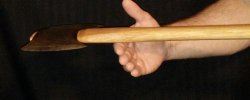- Joined
- Nov 7, 2016
- Messages
- 796
Claims have been made to the "balance" of American felling axes. Claims have been made that a plumb line will fall in front of the eye on most American axes. Claims have been made that the Council tool Classic Jersey has perfect balance. Claims have been made that there is no such thing as "perfect" balance. I am not naming names.
I am putting these pictures here because I said I would. Quite some time ago. Then forgot. I will be labeling the pics in a min......
Handle shapes are different and effect balance so take it as you will
Kelly perfect Jersey. Very good heel to toe. Handles like a dream. Could use more "cheek" in my opinion. (For what I use it on)4lbs

Plumb Victory Michigan. Bit heavy. Typical for a Michigan. 3.5lbs

4lb beat up Plumb with phantom bevels. Amazing balance.

Collins homestead Dayton. 3.5 lbs. Bit heavy. Typical for a Dayton.

Fulton 3.5 Michigan. Great balance for a Michigan.

3.5 Council Classic. Anyone who says this has perfect balance is either full of it or does not understand ax balance. Period. Bit heavy. 3.5lbs

Clear-cut 3.5lb double bit. Perfect balance. Obvious.

These plumb line shots speak for themselves.
Kelly perfect.......

Plumb 4 lb

Clear-cut

Council

Fulton. Both the head,(balance and geometry) and the handle made this axe an excellent preformer. Especially balance as it is a Michigan. I was truly surprised by this one.

Collins Dayton. This was a 32 inch handle.

I am putting these pictures here because I said I would. Quite some time ago. Then forgot. I will be labeling the pics in a min......
Handle shapes are different and effect balance so take it as you will
Kelly perfect Jersey. Very good heel to toe. Handles like a dream. Could use more "cheek" in my opinion. (For what I use it on)4lbs

Plumb Victory Michigan. Bit heavy. Typical for a Michigan. 3.5lbs

4lb beat up Plumb with phantom bevels. Amazing balance.

Collins homestead Dayton. 3.5 lbs. Bit heavy. Typical for a Dayton.

Fulton 3.5 Michigan. Great balance for a Michigan.

3.5 Council Classic. Anyone who says this has perfect balance is either full of it or does not understand ax balance. Period. Bit heavy. 3.5lbs

Clear-cut 3.5lb double bit. Perfect balance. Obvious.

These plumb line shots speak for themselves.
Kelly perfect.......

Plumb 4 lb

Clear-cut

Council

Fulton. Both the head,(balance and geometry) and the handle made this axe an excellent preformer. Especially balance as it is a Michigan. I was truly surprised by this one.

Collins Dayton. This was a 32 inch handle.

Last edited:


